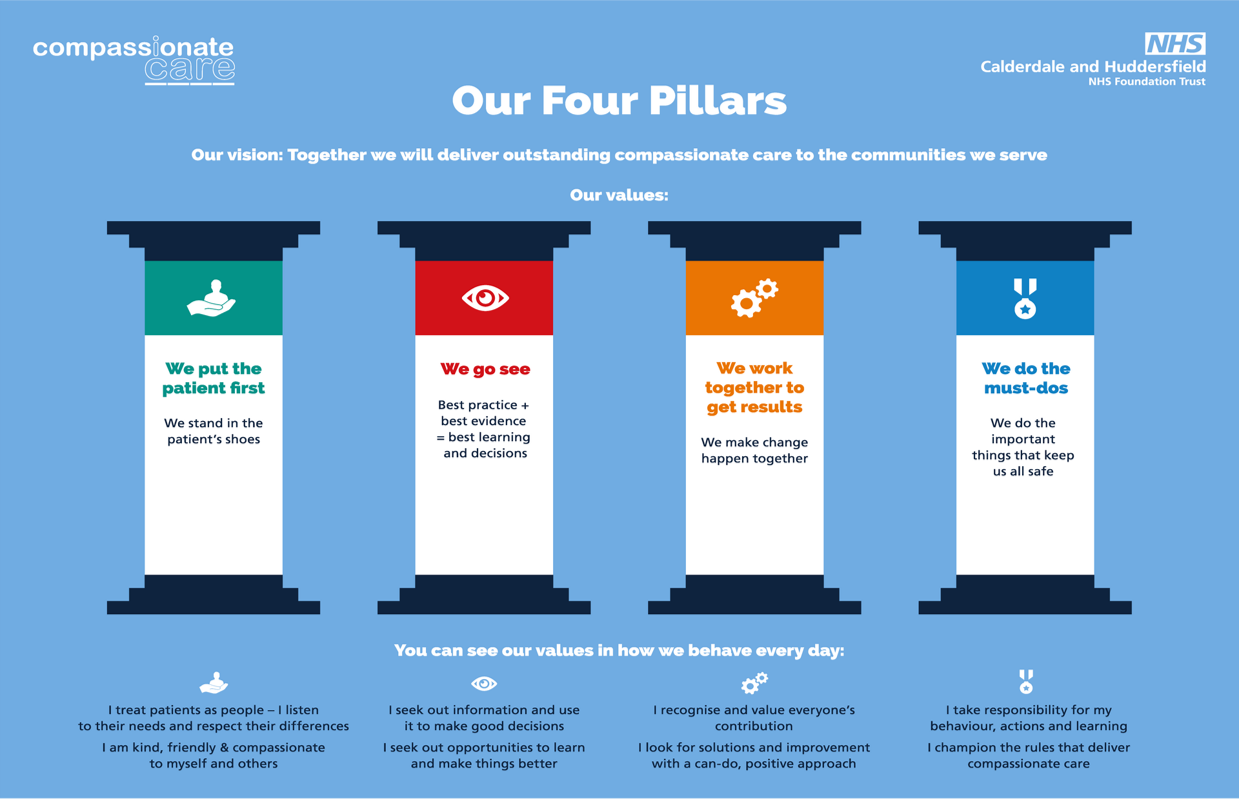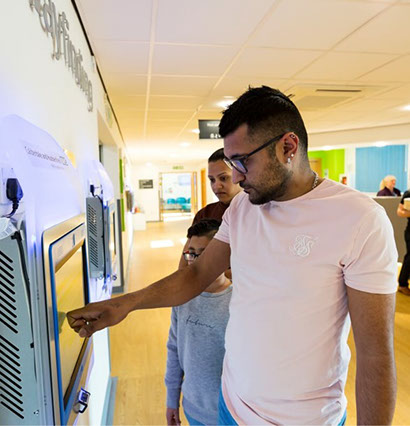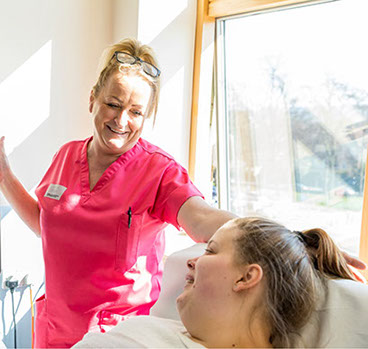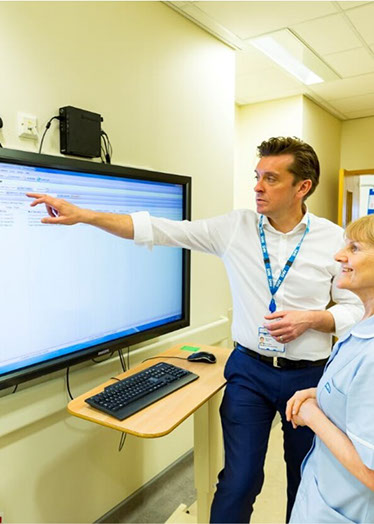Our Digital Future
The Digital Strategy will be delivered using the behaviours and values of the four pillars.

CHFT have continued to improve on the digital functionality and maturity of the healthcare environment. A number of projects are in progress and will conclude during the life of the strategy.
Theme | Project | Outcome |
|---|---|---|
Transformational | Outpatient Transformation | Supporting the delivery of the Virtual Consultations for Outpatient Clinic utilising Microsoft Teams Booking App. |
Patient Portal | Re-launching of the patient portal followed by increase adoption and improvements in the content. | |
Agile Working | Supporting Agile Working Principles to maximise the opportunity of using collaboration tools like MS Teams. | |
Partnerships | Health Information Exchange | Enabling our Primary Care to view the live patient record from within their own system (EMIS/Systm One) |
Medical Interoperability Gateway (MIG) | Enables Secondary care to view Primary Care with further developments into the social care record, Ambulance and the mental health trust. | |
Scan 4 Safety | Continuation of the 3 Year Scan 4 Safety Programme harnessing the power of scanning capabilities to improve patient outcomes. | |
LHCRE | Local Health care record extend interoperability across the whole region, allowing the sharing of key patient information. | |
Upgrade to Cerner version | Upgrade to the latest version of our Electronic Patient Record (Cerner Millennium). | |
Digital Health Team | Endoscopy | Nursing documentation is completed into the Electronic Patient Record viewable to all immediately resulting the removal of paper. |
Voice Recognition | Deployment of Voice Recognition technology throughout the organisation | |
Ascribe Integration | Integration from the Ascribe system into the Electronic Patient Record to the digital end to patient improving safety | |
Medisoft Integration | Ophthalmology integration for clinical and booking information | |
E – Consent | Ability for patients to electronically and virtually provide consent for procedures | |
Electronic Document Management system | Upgrade to support the storage of electronic documentations and open in context |
Our Digital Future – Continuation

Reconfiguration and Digital
In December 2018 DHSC announced £196.5m for reconfiguration for the trust. The Service Model for both sites will be reconfigured the some of the key aims:
- Improve Clinical Outcomes and Safety
- Improve Service Delivery and Patient Experience
- Improve the recruitment and retention of staff
- Optimise the use of available hospital estate
- Create a therapeutic healing patient environment and a high-quality working environment
The design of the building will incorporate the latest advancements in digital technology and be aligned to the Digital Health Strategy. The intention is to incorporate future proofing to ensure that when the emerging technologies are at a mature stage these advancements can be included.
The Digital strategy will aim to provide a robust digital platform for the new building design and service models. We will ensure our network capacity meets the needs of our digital expansion.
The principles described in the Trusts infrastructure strategy are designed to give direction for the Trusts IT infrastructure and also provide the basis for long term investment and decision making. The principles will contribute to the Trusts economic sustainability and also be adaptable to any reconfiguration requirements as part of the Trusts overall strategic plan.
"Designing the new hospital with digital at the heart of the design from the onset is a fantastic opportunity"

Infrastructure
To support the aspirations of this Digital Strategy, it will be essential to provide a robust and responsive infrastructure that will sit at the heart of all we do. The infrastructure needs to support a hybrid of legacy and future system provision thus ensuring it will provide the platform required to transition to modern ways of Cloud and service provision.
It needs to enable staff to have a positive user experience when interacting with any of the digital systems they use through the provision of a modern digital workplace where staff can easily and quickly find the information they need, wherever they need it, be that in a clinical, corporate or home working environment thus ensuring that many of the barriers that can often be associated with digital adoption are removed.
"A robust and responsive infra-structure that will sit at the heart of all we do"
As more digital systems move to a modern way of delivery, such as Apps and Containers, the devices that are used to interact with them should support that move to a more modern way of working too. Moving away from the multiple devices required currently to enable staff to carry out their roles, we must look to rationalising devices so that we can bring the hospital into the palm of their hands for as many systems as possible on a singular device. Enabling collaboration by removing the need to be physically present and supporting modern ways of multidisciplinary working using voice and video technology will be a key enabler for many strands of this strategy.
Underpinning all of this is a requirement to ensure that the infrastructure will ensure staff, patients and the organisation are protected from the ever evolving world of cyber security threats whilst staying compliant with the many mandatory and regulatory requirements such as the Data Security Protection Toolkit (DSPT), General Data Protection Regulation (GDPR) and the Data Protection Act 2018 (DPA 2018).

Optimisation
We recognise our digital ambition does not solely lie in bringing in new technology and innovation, optimising our current systems is at the centre of our aspirations. From our staff engagement we found that colleagues were keen to move from a point of adoption of digital to a phase of optimisation.
Optimising the use of technology will allow patient pathways to be improved, communications will work seamlessly helping us produce a much richer Electronic Patient Record (EPR). This in turn will deliver better patient care, improve reporting and increase staff satisfaction improving all our working lives.
Optimisation will involve a diverse group and we will identify Digital Ambassadors within each division to help share our ambitions and be a resource to both help optimise but also to help embed our digital message. Optimisation will not just focus on improving the digital record but how we interact digitally within our community embracing all levels of digital adoption.
A plan will be developed and resourced to ensure our workforce have the tools, knowledge and support that will enable them to be prepared for all our digital developments new and old in line with the Topol review published in 2019.
"A plan will be developed to ensure our workforce are prepared for all our digital developments"

Patient Experience
The NHS Long term Plan is looking at improving how services are delivered. Building on the progress already made on digitising appointments and prescriptions they describe "a digital NHS ‘front door’ will provide advice, check symptoms and connect people with healthcare professionals. The Coronavirus Pandemic will also give reason to review the plan and the progress that has been made, at pace, against the key deliverables.
"We want to improve our communication methods and accessibility"
Project 2020
Transforming Patient Services across CHFT and the local health communities has seen a variety of new clinical service models and pathways being developed. The strategy will continue to develop the principles set out in the project to improve the patient experience. Offering choice, for some patients, would mean a reduction in the traditional face to face visits to the hospitals. Engagement will be outside of the hospital building and, in the homesd/communities of our patients. Improving our communications methods and accessibility through different channels such as
- Patient Portal
- Virtual Consultations
- E Consent/Virtual Consent
- SMS Messaging
- Software Applications
- Self-assisted care solutions
- Virtual visiting
Ensuring patients are supported on their digital journey in accessing the hospital in a virtual manner will be provided to ensure Digital Inclusivity. Improving convenience for patient's alternative consultation methods can have a significant impact on population health by reducing NHS related travel. The NHS Long Term Plan (2018) has set targets of 33% reduction of current hospital-based outpatients' activity over the next 5 years.

Digital Skills
Digital features heavily for the majority of people in our lives from social media, internet shopping and banking now becoming mainstream. Accessing healthcare through digital means will continue to grow and forecast predict it will continue to rise.
Digital is an enabler that can bring communities together and can transform care for patient groups however there are people within these communities that lack the necessary digital skills. To support digital skills will provide easy to use guides/videos to enable to people upskill where appropriate.
When introducing digital solution that patient’s involvement ensuring equality and diversity/inclusivity will be at the forefront of the design
Digital Isolation
Digital Isolation
Digital isolation is where patients do have the technology or infrastructure to participate in the digital solutions offered. Supporting those patients that are digitally isolated to access hospital in virtual manner needs a partnership approach as other services for instance from the council/central government are provided digitally. This will ensure that we do not duplicate effort but also ensure the community have a consistent approach.
Our engagement in regional forums such as Kirklees Digital Board is supporting us tackling digital inclusivity at a community level building that greater picture. Going forward greater emphasis on the Digital Skills will enable us to capture.
"CHFT have an ambition to achieve a HIMSS stage 6 in 2020/21"

Ambition
CHFT is now part of the national Aspirant programme and are expected as part of this programme to build on the work already undertaken Global Digital Exemplar organisations. The programme was awarded to both CHFT and BTHFT in order capitalise on the EPR single Instance and a placed based expansion of digital technology
Both CHFT and BTHFT have a shared ambition to achieve a HIMSS stage 6 in 2020/21 Both trusts have committed to a joint project to complete the remaining safety elements of HIMSS level 6 these elements include.
- Closed loop technology for Medication, blood products and Human Milk administrations
- Cardiology imaging accessed through EPR
Currently there are only 6 hospital trusts at stage 6 and zero at stage 7. This accreditation will provide the opportunity for CHFT to once again be recognised as one of the NHS advanced digital leaders
The Aspirant programme will help fund some but not all our digital ambitions, the investment plan already details the current investment in digital so we intend to review our investment plans regularly as there will always be significantly more demand for digital then there is funding.
We will introduce some priority principles so we can ensure investment decisions offer the appropriate evidence through-out the governance process
Options appraisals will also be developed that will encompass areas that require significant investment such as Cardiology, Intensive care, theatres and Endoscopy. We need to ensure that these critical clinical systems are not constantly being de-prioritised purely on cost, when we know that by simply digitalising documentation can only be a short-term solution.
Prioritisation
Cerner Millennium is the core clinical system for the Trust, and it has always been the intention to adopt a “Cerner First approach” as we grow its functionality. The recent focus has switched to developing a plan to integrate existing systems that can be accessed through Cerner ensuring all healthcare professionals have a single access route to patient information really pushing the boundaries around interoperability and integration whilst aligning with the Trust objectives describe in the 5year strategy, plan on a page on delivering a robust interoperable EPR that is used by patients and clinicians alike. The engagements sessions highlighted colleagues supported a focus on the interoperability and integration of existing systems in order to make access to patient information seamless and efficient. A set of criteria have been agreed that will help prioritise those systems yet to become part of the core clinical system.
1. Patient Outcome | 2. Statutory Regulations | 3. Burning Platform | 4. Funding Limits |
|---|
System | Outcome | System | Outcome |
|---|---|---|---|
Infection Control Solution | Reduce number of incidents and improve patient safety | NICU Badger Net | Eliminate the need of an integration solution |
Cardiology ( All systems) | To enable access to all results and reporting and imaging within EPR | Integration of medical devices | Improved Quality and safety enable the transfer of results straight into EPR |
ICU ( Ward watcher) | Improve Patient safety | Pathology | To enable access to all results and reporting within EPR |
Theatres | Introduce anaesthetic module as overall package | ICE | GPs to place orders direct into EPR |
Maternity | Cerner used for all patient encounters across the trust | e Prescribing advances | Improved patient safety by Closed loop / dose range checking. |
Audiology | To enable access to all results and reporting within EPR | Radiology (HSS RIS) | To enable access to all results and reporting within EPR |
Neurophysiology | To enable access to all results and reporting within EPR | Oncology (PPM) | Improve stability across multiple organisations (MDT) |

Innovation
One of the challenges and opportunities Digital presents is the constant pace of change in digital technologies. Building the ability to horizon scan and establish how these emerging technologies can benefit and be introduced into CHFT.
- Virtual Reality
- Drones
- Predictive Analytics
- Artificial Intelligence
- Robotics
- Robotic Process Automation
Just some themes where the technology needs to be exploited and to ensure that we are at the forefront of the technological advancements and prepare to accept within the next 10 years
Innovation Hub
Over the next 5 years we want to establish an Innovation Hub to create a physical and virtual space which will support us in developing the upcoming digital trends. The objective is for all Digital Ideas, concepts to developed in this space and an opportunity to showcase our digital work. It will allow us to be better informed around our digital ambitions as we confirm the design plans for the reconfiguration.
